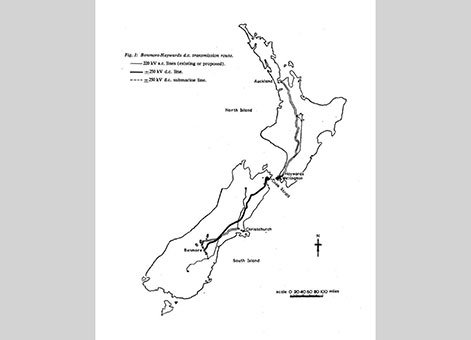The high voltage direct-current (HVDC) link between Benmore and Haywards is a 600 megawatt (MW), 500 kilovolt (kV) HVDC transmission link that integrates power supply between New Zealand's South and North Islands.
When built in 1965 it was the world’s largest and longest, incorporating the world’s largest submarine cable. Many technically complex parameters were extended by its innovative engineering achievements.
The development and construction of the Benmore to Haywards system is the subject of a New Zealand National Film Unit film, The First Half Million Volt D.C. Transmission Line (1965).
The cable allowed good management of the varying water storage patterns of the two islands and enabled cheap South Island power to be exported to the North Island. It also aided the integration of all New Zealand energy resources. The project was not achieved without considerable difficulty but has proved to be of enormous value to New Zealand.
Although many took part in the design, construction and management of the project the initial vision and driving force must be credited to MG (Bill) Latta, Chief Engineer of the State Hydro-Electric Department, whose pioneering paper in 1950 showed that the end of economic North Island hydroelectric development was in sight and that the solution was to cross Cook Strait with submarine power cables and link with untapped power in the South Island.

Cook Stright power cables being laid from Oteranga Bay, Wellington [12 November 1964]. Alexander Turnbull Library, Wellington, New Zealand.
The HVDC Link was one of the most ambitious heavy electronic projects undertaken in New Zealand and the world at the time of its inception and it contained many new aspects of power transmission. For example, it was the first use of solid/magnetic controls for HVDC transmission, and third generation mercury arc valves for transmission. In 2015 the link marked 50 years of successful operation.

Benmore-Haywards D.C. transmission route. New Zealand Engineering, Vol. 21:4 (April 1966), p.146.
Heritage recognition
IPENZ “Engineering to 1990” project
This item of New Zealand’s engineering heritage was recognised as part of the IPENZ “Engineering to 1990” project, which the Institution organised to help celebrate the country’s sesquicentenary in 1990. A plaque was unveiled to mark the significance of this transmission system as part of the development of the nation.
More information
Access
The Haywards converter station is not open for public viewing. The Benmore Power Station has a viewing platform.
References
AL Williams, EL Davey and JN Gibson, “The 250kV d.c. Submarine Power-cable Interconnection for the Benmore-Haywards h.v.d.c. Transmissiobn Scheme,” (PDF 1MB) New Zealand Engineering, Vol. 21:4 (April 1966), pp.145-160.
Location
The northern terminus is at Haywards, on State Highway 58 between Manor Park and Paremata, in the Wellington area. The southern terminus is at Benmore Power Station on the Waitaki River, North Otago.
